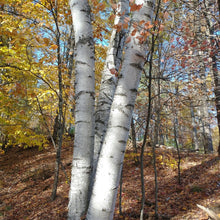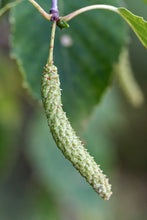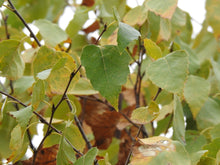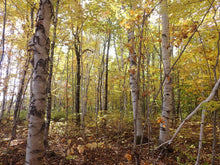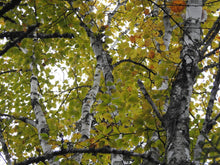
Betula papyrifera
Paper birch is a graceful, medium-sized tree often used in landscaping for its striking white bark, elegant form, and ability to attract wildlife such as birds and small mammals. In spring, its fresh, bright green, egg-shaped leaves emerge creating a striking contrast against the distinctive white, peeling bark. Male and female catkins dangle ornamentally and eventually drop after they bloom. As the season progresses, this species produces small, winged fruit called “samaras”, which ripen in June or July, depending on the specific location and local climate conditions. These seeds are dispersed by the wind and help the tree regenerate in the surrounding area. The tree's dense canopy provides shade with darker green leaves that flutter in the breeze, creating a soothing atmosphere. In fall, the leaves turn a brilliant yellow, adding a vibrant splash of color before they drop for the winter.
- Plant type/canopy layer: deciduous, perennial, medium-sized tree
- Size at maturity: 50-70' tall, 10-40' wide canopy
- Light requirements: full sun, part sun/part shade
- Moisture requirements: moist to wet soil
- Bloom time: April - July
- Growth rate/ease: medium to fast growing, easy to grow
- Wildlife support: leaves and twigs are browsed by beavers, porcupines, chipmunks, hares, elks and deer; peeling bark is used as nesting material by many birds and small mammals; tree cavities are used by birds and mammals for nesting and roosting sites; seeds are eaten on and under the trees by juncos, finches, siskins, sparrows, grouse and small mammals like voles and shrews; the overall tree is a host and larval food source for mourning cloak and swallowtail butterfly larvae and provides critical habitat for countless species of insects, which in turn become critical prey for woodpeckers, kinglets, warblers, nuthatches, chickadees and sapsuckers
- Native habitat/range: most commonly found at lower to mid-elevations, particularly in moist, well-drained soils along riverbanks, in marshes, wetlands, along bog margins and in forested areas. In the higher elevations up to 1370 meters, it may be found at the edges of montane forests. It is widespread in North America particularly Canada; on the West Coast it is considered native from Alaska to eastern Oregon, and into northern Idaho and western Montana. Portland Plant List - no.
- Special features & uses: Ethnobotanically, many indigenous cultures (including the Bella Coola, Carrier, Gitksan, Okanagan-Colville, and others) have been known to use the bark and wood to make baskets, canoes, toboggans, dishes, cooking and eating utensils, containers, waterproof wrappings, torches, fish traps, cradles, casts for broken limbs, roofing material, construction material, hats, drums, wedges, spears, bows, decorations, paper, carvings, and tool handles. The wood is useful firewood. The inner bark can be used to make brown dye and the roots can be used as a sewing material. The sap/resin has been used as a food source (mixed with fish grease) and an adhesive; the resin is also used medicinally as a cold or cough remedy. (Washington Native Plant Society)
Gardening with Paper Birch: To successfully landscape with paper birch, plant it in a location that receives full sun to partial shade. It prefers moist, well-drained soils, such as loamy or sandy loam. It has a graceful, upright growth habit, making it ideal for providing vertical interest in landscapes. All birches attract aphids, which is part of what makes it such an excellent habitat tree (aphids = food for predatory insects and birds) - however it is important to note that the sticky “honeydew” associated with aphid/plant interaction makes this species not a great choice for patios or parking areas. It is “short-lived” for the PNW tree, meaning it typically lives 125-200 years.
Try pairing it with native companions, such as shrubs like red twig dogwood (Cornus sericea) and Western hazelnut (Corylus cornuta var. californica), with sword fern (Polystichum munitum) and red columbine (Aquilegia formosa) planted in multiples on the garden floor.
Photo Credit 1 (in fall): © Tom Norton, some rights reserved (CC-BY)
Photo Credit 2 (catkin): © Bill Keim, some rights reserved (CC-BY)
Photo Credit 3 & 4 (leaves, forest population): © Alexis Godin, some rights reserved (CC-BY)
Photo Credit 5 (branches-leaves): © Rachel Stringham, some rights reserved (CC-BY)





